to enlarge


or choose the place
from the menu below
 Rome |
 Byzantium |
 Venice |
 Vienna |
 Brioni |
 Smrikve |
 |
 |
From 1511 Buzet was a Venetian administrative centre, where the Raspor’s Captaincy was headquartered.
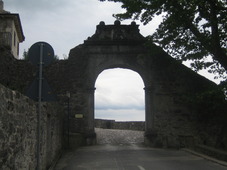 Buzet has oval structure and the visit of the town starts passing trough the large
town gates dating back to 1547. There are several interesting buildings in the old town. When you enter the town,
there are two streets you can take. Both will take you towards the main square where the Parish Church is located. If you
take the street on your right side you will see some nice palaces with their stone coats of arms on the façades.
Buzet has oval structure and the visit of the town starts passing trough the large
town gates dating back to 1547. There are several interesting buildings in the old town. When you enter the town,
there are two streets you can take. Both will take you towards the main square where the Parish Church is located. If you
take the street on your right side you will see some nice palaces with their stone coats of arms on the façades.
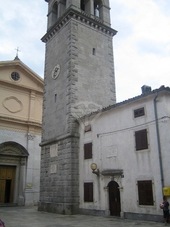 On the main square there
are several interesting buildings that you can see. There is the Parish Church of the Assumption of the Blessed Virgin
Mary, built in the 18th century, in front of which there is a 36 meters high bell tower built by Andrea Vivoda.
On the main square there
are several interesting buildings that you can see. There is the Parish Church of the Assumption of the Blessed Virgin
Mary, built in the 18th century, in front of which there is a 36 meters high bell tower built by Andrea Vivoda.
On the site of the current church there was an older one built in 1326. The current church was built between 1769 and 1784 by Filippo Dongetti from Piran and the Captain of Raspor Pasquale Cicogna. On the church’s façade there is a stone sculpture representing St.George slaying the dragon that was placed there in 1782 in honour and memory of Pasquale Cicogna.
Near the bell tower there is the native house of Stjepan Konzul Istranin. Stjepan Konzul Istranin was a defender of the Protestant ideas, writer and translator that lived in the 16th century.
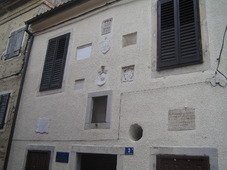 On the right side of the church there is the house of the Verzi family. On the opposite
side, on the left side of the church, there is the Captain of Raspor house. You will see several coats of
arms and stone inscriptions on the façade.
On the right side of the church there is the house of the Verzi family. On the opposite
side, on the left side of the church, there is the Captain of Raspor house. You will see several coats of
arms and stone inscriptions on the façade.
Opposite the Captain Raspor’s house, you will note the former Municipal palace. You will note that in Buzet’s old town every historic building has a note on the façade that indicates why the building was important.
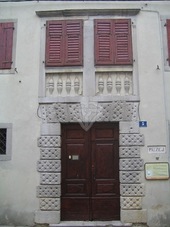 To continue the visit take the first street
on the left after the Captain of Raspor’s house and you will arrive in front of the town museum. This
building was a former Bigatto family house built in 1639. Numerous exceptionally valuable artefacts from
the Buzet necropolis as well as from the remains of the Roman settlement Pinguentum are kept in the museum.
To continue the visit take the first street
on the left after the Captain of Raspor’s house and you will arrive in front of the town museum. This
building was a former Bigatto family house built in 1639. Numerous exceptionally valuable artefacts from
the Buzet necropolis as well as from the remains of the Roman settlement Pinguentum are kept in the museum.
On the wall, on the left side looking towards the museum, there is a stone box from 1725 that was used to denounce the destroyers of the woods in the region: “denoncie secrete contro fanneggiatori dei boschi dela provincial”.
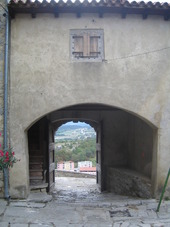 Another similar box, with Lion mouth, was placed on the Municipal palace in the 15th
century against the cutters of the vines and olive trees.
Another similar box, with Lion mouth, was placed on the Municipal palace in the 15th
century against the cutters of the vines and olive trees.
Now you are few meters away from the second town gates, named the small gates and built in 1592 by Podesta’ Carlo Salomon.
It is interesting that the coat of arms placed above the small gates is the coat of arms of the family Salomon dating back into 725. Opposite to the town gates there is the “fondaco”, the grain house. It is a building from the 16th century with several coats of arms on its façade.
Now you are very near to another small square that is characterized by a beautiful Baroque well in the middle. Since Buzet was a significant military and administrative Venetian stronghold it was important to build a water storage system.